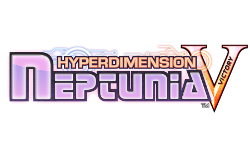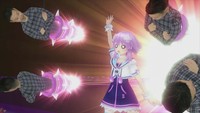|
|

|
PLATFORM
|
PS3
|
BATTLE SYSTEM
|

|
INTERACTION
|

|
ORIGINALITY
|

|
STORY
|

|
MUSIC & SOUND
|

|
VISUALS
|

|
CHALLENGE
|
Easy
|
COMPLETION TIME
|
40-60 Hours
|
|
OVERALL

|
+ Funniest Neptunia game yet.
+ Lots of interesting optional systems.
- Best systems are ignored and underused by the main game.
- Combat a big step down from the previous game.
- Way too many recycled assets.
|
Click here for scoring definitions
|
|
|
If you had asked me in 2011 if I expected Hyperdimension Neptunia to become a successful franchise, I would probably have laughed in your face. The original game is still among the worst games I've ever played. I certainly never would have expected to see a sequel only a year later in the form of Hyperdimension Neptunia mk2, and more importantly, I never would have expected it to actually be pretty darn good. And most surprising of all, I never would have expected to be legitimately excited for a third entry in the series. Hyperdimension Neptunia Victory is that third game, and although it's still a thousand times better than the original, it's a disappointing step down from mk2 in many ways.
For those not familiar with the series, Hyperdimension Neptunia takes place in the fictional world of Gamindustri, with four nations, each representational of a different hardware manufacturer, vying for the affections of the people. There's Lowee (Nintendo), Lastation (Sony), Leanbox (Microsoft), and Planeptune (SEGA). In this installment of the game, the series heroine Neptune is magically transported to an alternate dimension, where the nations are only just getting their feet off the ground. Despite much of the gaming press and even NIS America itself claiming that this latest iteration takes place in the 1980s, this isn't entirely true. The story appears to begin in the late '80s, early '90s with Lowee and Planeptune as the only nations in the area, but it quickly advances to roughly 1994, when Lastation makes its appearance. Time continues to advance quite rapidly, and the first half of the game is essentially a retelling of the console wars from beginning to end. It's easily the strongest allegory in the series to date. All told, roughly twenty years pass over the course of Hyperdimension Neptunia Victory, with one of the subplots actually involving watching developer mascots IF and Compa grow up from babies to adults.
Victory's story, from its plot to its characters to its allegorical references, are without a doubt the strongest in the series to date. The localization in particular is absolutely hilarious, with surprisingly clever jabs at everything from individual characters to major events in gaming history, and even several that make fun of the previous games in the series. One of the funniest running gags in the game involves Nepgear, the protagonist from mk2, suffering a severe inferiority complex because gamers and reviewers all complained she had no personality and they liked her sister Neptune better, a complaint I actually did levy in my own review. The writers appear to have thrown out the fourth wall altogether for this entry, and even when the story takes surprisingly dark twists, the banter between characters remains silly and humorous. Those knowledgeable about the series are probably expecting a certain degree of crudity, and it's still plentiful. The boob jokes are overly excessive in this iteration, and one of the new characters, Plutia, has a rather disturbing alter ego, but it thankfully stays far away from the more twisted stuff that mk2 got into. That said, it's definitely not a game for those easily offended. In a surprising twist, the writers actually found a way to turn the boob jokes into a hardware analogy, so at the very least they have a point to them... sort of.
 You can't have a Neptunia game without Keiji Inafune's torso on a rocket!
You can't have a Neptunia game without Keiji Inafune's torso on a rocket!
|
|
Not everything about the story is improved, though. The game developer mascots that had prominent roles in the previous two games are conspicuously absent apart from IF (Idea Factory) and Compa (Compile Heart). The mascots for NISA, Gust, 5pb, Falcom, and Cave don't even make an appearance, despite the first three being playable characters in mk2. IF and Compa are also missing from the battle party for the first time in the series, delegated to the role of mere NPCs. While the game's story does have a major focus on hardware rather than software, it would have been nice to at least see a cameo from them. That said, all the CPUs and CPU candidates make an appearance, three new ones are introduced, and Keiji Inafune's disembodied head is joined by the disembodied heads of several other Japanese game developers.
The gameplay is where the most significant disappointments occur, and they begin with the combat system. Battles take place in the same style as mk2 or the more recent Mugen Souls, but with some alterations. During each character's turn, she can move freely in a given radius. Once within range of an enemy, she can begin a combo attack or activate a special skill. The most significant difference from mk2 is that the AP system, which was surprisingly enjoyable and required a fair bit of interaction to make use of, has been replaced by a much simpler and less impressive CP system. In this new system, each character has a set number of CP points they can use to allocate combo attacks, three attacks each to the triangle, square, and X buttons. More powerful skills have higher costs. Unfortunately, this means that the dynamism of mk2's combat is lost, and the game falls into the same trap that the original Hyperdimension Neptunia fell into, where there is one set of attacks that are the best in every possible circumstance. Most players will discover that the best route is to simply ignore one of the three button sets and focus instead on equipping the most powerful abilities on the other two.
Combat is made more frustrating by the fact that almost all the bosses have extremely potent health regeneration. This makes the combat more of a numbers game, where strategy and planning takes a backseat to sheer levels. If players aren't able to outdamage the regeneration, victory is impossible, regardless of strategy. The final boss, as an example, regenerates 25,000 HP per turn in its ultimate form. She was unbeatable at level 80, as every time the party got close to defeating her, she would knock several party members out, and by the time they were revived, the boss had regenerated almost completely. Once the party reached level 90, it was relatively easy to win. On the plus side, levels are acquired rapidly, and raising the party from level 80 to 90 took less than an hour total.
Victory falls into another trap that the original title suffered from as well. Many of the game's more interesting systems are chronically underused, and in some cases require the player to go significantly out of their way. The game supports an eight-character party, four in battle and four in a passive, support role, but it's not until the very last dungeon that eight characters even become available. The game disc system, which allows players to create custom equipment by mixing and matching game attributes that can be found throughout Gamindustri, first requires players to acquire game disc items, which are only available by upgrading their side quest ranking, or going out of their way to track down and fight hidden monsters. With the latter option, the item drop necessary to acquire new discs isn't even guaranteed, which makes it a frustrating experience. The necessary monsters can only be found by making use of the Scout system, another great idea with poor implementation. Players can choose to send scouts out to the various dungeons, and depending on how much one decides to pay them, they might find new monsters, improve experience and drop rates, return with money or items, or even discover new dungeons. While it's great in theory, they only come back once time has passed, and time only passes by entering dungeons. In order to make decent use of it, players will have to devote a shocking amount of time to simply entering and leaving dungeons in order to force the clock forward.
 In an effort to force players to like her, the writers are cramming every personality trait possible on poor Nepgear.
In an effort to force players to like her, the writers are cramming every personality trait possible on poor Nepgear.
|
|
The quest system is yet another matter. While not strictly bad in any sense of the word, there's very little incentive to really do anything with it. The rewards are generally quite poor (often a new item crafting recipe, which is like rewarding a quest with a new quest), and the quests themselves never fall outside the fetch and hunt variety. Worse, there's virtually no direction given: you get an enemy or item name, but no suggestions as to where to find them or how to acquire it. In many cases, these items can only be found from the hidden monsters uncovered by the scout system, making them enormous time sinks. What's worse, Victory had the (admittedly hilarious) idea of reviewing the player's performance after each story chapter, Famitsu style, with ratings given for quests, scouting, nation market shares, and enemies defeated. Whatever the requirements for the quest bracket are, they must be ridiculous, as I personally never got a score higher than a three in that category. At the end of most chapters, apparently my performance didn't even warrant a score, and I got a zero. The most ironic part of it is that the "reviewer" for that category would remind me each time that the quests were there to make the game more fun.
The artistic direction, both visual and musically, is another area the game suffers. It's exactly like mk2, but not in a good way—the amount of asset reuse going on is frankly despicable. Enemy models, environments, even entire dungeon designs are lifted wholesale from the previous game. Likewise, the soundtrack contains many of the same tracks as mk2, and the lack of new content is very disappointing. The voice acting is solid for the most part, but as always, Neptune's spacy, ridiculous dialogue stands out above the pack. Another worthwhile mention is the over-exhuberance of villain Copypaste, though he's only voiced in a handful of scenes.
Despite a lot of issues in the gameplay, I actually had a lot of fun playing Hyperdimension Neptunia Victory, and that's largely in part to the humorous script and terrific localization job. Thankfully, despite the pitfalls, the game is relatively breezy and even fun if you're not forced to dig into the tedious optional content. It's also significantly longer than mk2, clocking in at over forty hours, meaning more laughs for the same price. If you're looking for a quirky JRPG story that pokes fun at your favorite hobby, look no further than this. But if you're looking for a deep, complex game experience, well, the game's story isn't the only thing stuck in the past.
Review Archives
|









